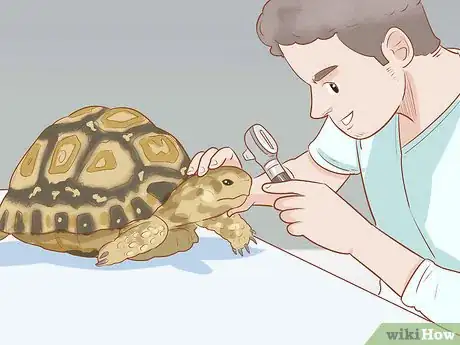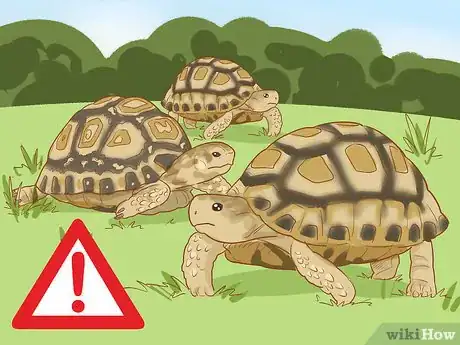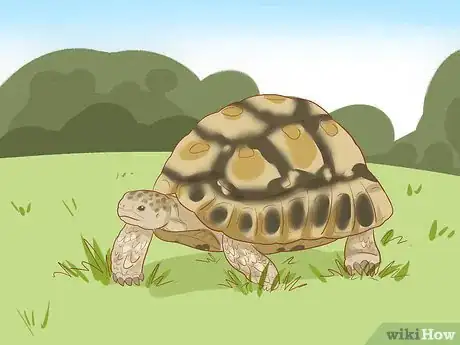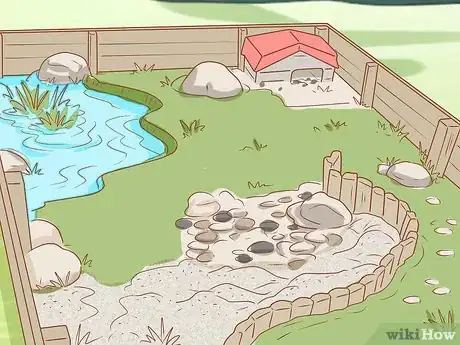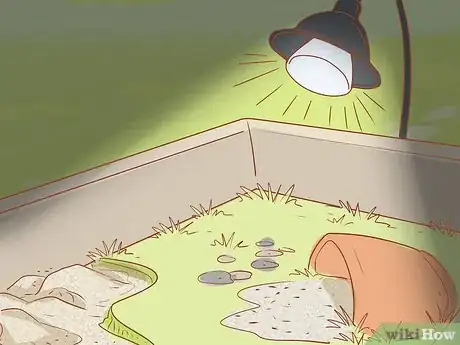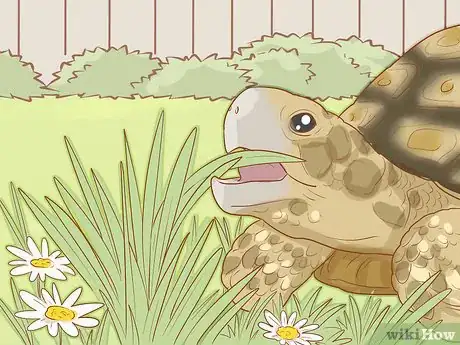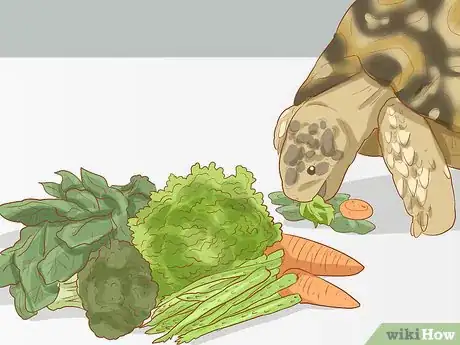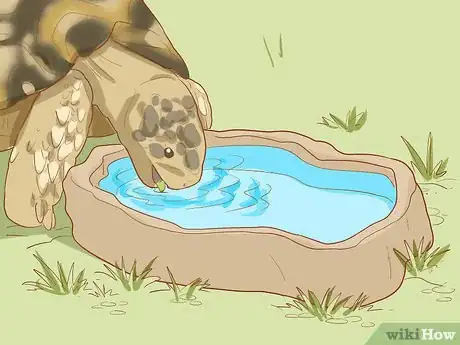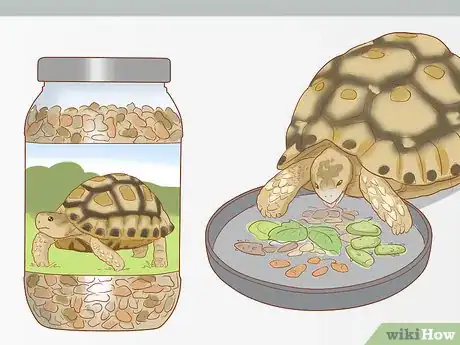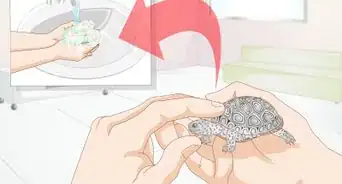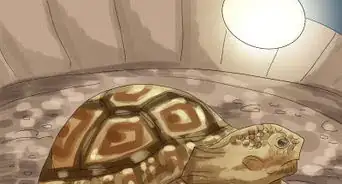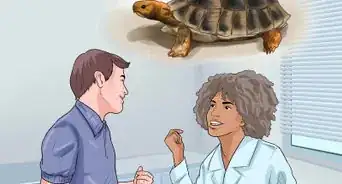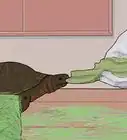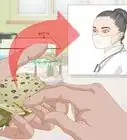This article was co-authored by Jaime Nalezny, DVM and by wikiHow staff writer, Christopher M. Osborne, PhD. Dr. Jaime Nalezny is an exotic animal veterinarian with over 15 years of experience, focusing on the care of birds, reptiles, amphibians, and exotic small mammals. Dr. Nalezny founded The Iguana Relocation Network and is on the board of directors for Midwest Avian Adoption & Rescue Services. She graduated from the University of Minnesota College of Veterinary Medicine in 2005.
wikiHow marks an article as reader-approved once it receives enough positive feedback. In this case, 95% of readers who voted found the article helpful, earning it our reader-approved status.
This article has been viewed 191,388 times.
A leopard tortoise (geochelone pardalis) can grow to about 2 ft (0.61 m) long and weigh up to 70 lb (32 kg) with the right care. They make wonderful pets—though they can be rather shy and withdrawn—and may live up to 80 years if kept healthy throughout their lives. However, to care for them properly you must provide a large enclosure, protection from cool temperatures, and a nutritious diet, among other requirements.
Steps
Keeping Your Tortoise Happy and Healthy
-
1Acquire a healthy tortoise from a reputable source. If you know of a reliable, reputable pet store that specializes in reptiles, they may have a healthy tortoise for you. Better yet, contact a well-regarded tortoise breeder and get one directly from them. Don't get a tortoise from an expo or store where many stressed animals are put together, because they can catch diseases in that environment.[1]
- Avoid tortoises from private sellers, especially if they can't provide you with detailed information on the tortoise's origins and health history.
-
2Examine the tortoise's features carefully before buying it. Make sure that its eyes are clean and glossy, not cloudy or filmy. Also, check that the eyes don't have bubbling or frothing and that there is no nasal discharge when you push on the top of the muzzle, because those are signs of respiratory disease.[2]
- If you can see the fecal droppings, they shouldn't be runny.
Advertisement -
3Get regular vet checkups, ideally with a reptile specialist. General veterinary care is most certainly better than none at all, but look for a vet with lots of experience working with reptiles—or, best of all, tortoises. Take your tortoise in for checkups once per year, or on the schedule recommended by your vet.[3]
- To find a specialist vet, search online for "reptile specialist veterinarian near me," or (in the U.S.) try the "find a vet" tab at https://arav.org/.
- If you notice any sudden changes in your tortoise's behavior, or in its feeding or defecating habits, contact your vet for an appointment.
-
4Socialize tortoises early, but at their comfort level. When the tortoise is still a baby, begin socializing it by gently picking it up and holding it in the palm of your hand. Do not tap on its shell or yell at it to come out, as this will frighten and stress the tortoise. Instead, let it take cover inside its shell until it is ready to come out on its own accord.[4]
- As your tortoise grows older and realizes you are its food and care provider, it may become comfortable enough to eat right out of your hand—and it may even let you pet it sometimes.
- Some tortoises never become comfortable being held or interacting with people, however. If it hides in its enclosure or withdraws into its shell whenever people are around, simply let it be. They're still fun animals to watch!
-
5Don't acquire more tortoises than you can handle. Leopard tortoises aren't territorial, so you can keep a mix of several males and females together if you wish—although you'll end up with baby tortoises that way! However, they're also perfectly content in pairs and usually even when living alone.[5]
- Because of their size, keeping more than 2 tortoises will require a great deal of space—not to mention all the food and supplies!
-
6Soak a baby tortoise in warm water 2 or 3 times a week. Warm up water so that it is between 80 to 90 °F (27 to 32 °C). Soak your tortoise for about for about 15 minutes. Soaking your tortoise helps them rehydrate, because they'll drink the water as they soak. Your tortoise may defecate in the water, and if so, just dump the water in the toilet and refresh it.[6]
- Don't leave water standing in the enclosure for more than a day, because it can get dirty and make your tortoise sick.
- As your tortoise grows, you can replace the soaking by offering a pan of clean, shallow water once or twice a week for your tortoise to crawl into in addition to their everyday water supply.[7]
Housing Leopard Tortoises Outdoors and Indoors
-
1Keep a leopard tortoise outside whenever the climate permits it. The leopard tortoise is found natively throughout south and east Africa, in dry or semiarid climates with lots of grass. They thrive in areas with a mix of sun and shade and medium humidity. The daytime temperature should be about 80 to 85 °F (27 to 29 °C), with a basking area available of about 95 °F (35 °C). The nighttime temperature shouldn't fall below 75 °F (24 °C). If you can meet these conditions outdoors, your tortoise will be happiest.[8]
- Leopard tortoises should never be exposed to temperatures below 60 °F (16 °C), and need ample shade and air movement if the temperature is above 95 °F (35 °C).
- Because of their large size (and the large enclosures they therefore need) and the warm and sunny climate they require, leopard tortoises aren't ideal pets in every climate. While you can keep them indoors permanently, it will take a significant investment of time and money on your part to house them properly.
-
2Set up a large outdoor habitat with a mix of sun and shade. Enclose an area that's at least 10 ft × 10 ft (3.0 m × 3.0 m) with solid (non-transparent) walls that are at least 18 in (46 cm) high. Make sure the pen has a sunny spot with little or no grass on it (for sunbathing), and lots of tall grasses and shrubs (for shade and hiding) elsewhere.[9]
- There should also be a “hide box”—an enclosed area that the tortoise can retreat to for safety and some “alone time.” A doghouse can serve this purpose.
- Leopard tortoises aren't much of an escape risk if the walls are 18 in (46 cm) high, but the walls should be solid so they can't see outside the pen—tortoises can be easily frightened by what they see out there!
- Up to 2 adult tortoises can be kept in a 10 ft × 10 ft (3.0 m × 3.0 m) enclosure, but if they are both male it will have to be larger. To figure out minimum sizing for 2 adults, measure their shell lengths, add them together, and then multiply by 4.
-
3Set up a large indoor habitat for times when the climate isn't ideal. While a pair of baby leopard tortoises can be kept in a 2 ft × 2 ft (61 cm × 61 cm) terrarium with smooth, 12 in (30 cm) walls, 1-2 adults need, at bare minimum, a 4 ft × 8 ft (1.2 m × 2.4 m) enclosure with 18 in (46 cm) walls. Some tortoise-keepers resort to using an extra-large soaking tub or a rigid kids' pool to make such an enclosure.[10]
- The indoor enclosure should also have a “hide box”—a cardboard box can be made to serve this purpose.
-
4Add 2–3 in (5.1–7.6 cm) of hay to the indoor enclosure and clean daily. Ideally, the indoor enclosure will have grass hay on the bottom, with planted grasses for grazing, and dry areas for basking. You can also use a mix of soil and mulch, shredded paper, or newspaper if hay isn't available. Avoid using wood shavings, because they can harm your tortoise's health.[11]
- Remove any newspaper or hay soiled by droppings or food daily.
- Replace all the newspaper or hay (and clean the enclosure) weekly.
-
5Set up UVB and heat lamps for indoor enclosures. Healthy tortoises require several hours of daily exposure to UVB light. If your leopard tortoise doesn't live outside, you'll need to buy a UVB lamp that puts out a wavelength between 280-320 nm. Plastic, plexiglas, screens, and glass all filter out UVB, so you should get a lamp even if your enclosure is near a window. The bulbs should be within 6 to 12 inches (15 to 30 cm) of your leopard tortoise, and turned on for 12 hours daily. Be sure to get a UVB that is appropriate for leopard tortoises, such as Reptisun™, Powersun™, or Mega-ray™ UVB.[12] Use red light heat lamps or other heating elements to keep the enclosure between 75 and 90 °F (24 and 32 °C).[13]
- Measure your UVB output with a meter like the Solarmeter 6.2 or 6.2R, to determine if your bulbs are outputting the right amount of light.
- Different UVB lights put out different amounts of UVB and types of beams, so make sure you are getting one that's good for leopard tortoises.[14]
- Check that your heat lamps are putting out the right temperature with a digital temperature gun.
Providing a Nutritious Tortoise Diet
-
1Offer a diet of grasses and straw. Leopard tortoises need a high-fiber, high-calcium, low-protein diet, so grasses and straw are the perfect food for them. Timothy, orchard, brome, oat, and meadow grass are all good choices for indoor enclosures. In the outdoor enclosure, let the tortoise graze on palatable weeds and wild plants such as clover, dandelions, and wild grass.[15]
- In an outdoor enclosure, you might want to plant some grass or alfalfa for the tortoises to eat.[16]
-
2Give the tortoise dark leafy greens and veggies a few times a week. Feed adults 2-3 times weekly and hatchlings daily. While grasses and straw should provide 50%-80% of your tortoise's diet, dark, leafy greens like kale and collards are great supplemental choices. You can also offer veggies such as the following, cut into bite-size pieces: carrots, squash, sweet potatoes, pumpkins, carrots, and bell peppers.[17]
- Cut-up fruit can be offered as a very rare treat, but less than once a month—the high water content would cause gastrointestinal issues if your tortoise eats fruit too often.
- Iceberg lettuce has next to no nutritional value and is not an ideal food source for a tortoise.
-
3Provide a constant supply of clean, fresh water. Use a sturdy, low-sided water bowl that the tortoise can easily access for drinking. Whether indoors or outdoors, check regularly to make sure there is fresh water in the dish at all times. Empty and clean the bowl daily as well.[18]
- Younger tortoises in particular may like to bathe in the water dish as well. This is fine—just make sure to keep the dish filled and clean, with shallow enough water to prevent drowning.
-
4Give commercial tortoise feed and/or supplements as recommended. Follow your vet's advice about whether commercial tortoise food pellets are a good choice for your pet. The pellets may provide nutrients that are lacking in your tortoise's regular diet, although most tortoises can thrive on a well-balanced grasses-and-hay diet.[19]
- If you're diluting the pellets with greens and other food items, the diet may become imbalanced, so it's best to talk to the vet to set up the best diet plan for your individual leopard tortoise.
- Provide supplements only if (and how) recommended by your vet. Due to their rate of growth, a leopard tortoise's demand for calcium and mineral trace elements is high. A calcium-D3 daily supplement might be recommended for juveniles and, less often, adults.
Warnings
- Tortoises are known for being very slow, but when scared they can actually run quite fast. You may be tempted to entice your tortoise to run because you think it's fun to see. Do not do this. Their little hearts can't take it, and it is very stressful for them to be running for their lives repeatedly.⧼thumbs_response⧽
- Never leave a tortoise outside on a cold night or let the pen get too cold. Tortoises are highly susceptible to respiratory infections and will likely die if left in cool temperatures for too long.⧼thumbs_response⧽
- Never capture a tortoise (or any other pet) in of the wild. They may carry bacteria and diseases that could infect your household.⧼thumbs_response⧽
- Avoid buying your tortoise online or through a pet broker if at all possible. This will not allow you to examine your new pet beforehand, and the shipping process will place undue stress on your pet before your even receive it.⧼thumbs_response⧽
- Don't tap on its shell. This is very disturbing and annoying.⧼thumbs_response⧽
- Don't get a tortoise if you don't have room for it to live comfortably.⧼thumbs_response⧽
- Don't feed a leopard tortoise food pellets designed for box tortoises, since a box tortoise is an omnivore and eats both vegetables and meat.⧼thumbs_response⧽
References
- ↑ http://www.reptilesmagazine.com/Care-Sheets/Leopard-Tortoise/
- ↑ https://veterinarypartner.vin.com/default.aspx?pid=19239&catId=102919&id=8017697
- ↑ https://lafeber.com/vet/wp-content/uploads/Leopard-Tortoise-Latney2.pdf
- ↑ https://lafeber.com/vet/wp-content/uploads/Leopard-Tortoise-Latney2.pdf
- ↑ http://www.reptilesmagazine.com/Care-Sheets/Leopard-Tortoise/
- ↑ https://azeah.com/tortoises-turtles/basic-care-leopard-tortoise
- ↑ https://azeah.com/tortoises-turtles/basic-care-leopard-tortoise
- ↑ https://lafeber.com/vet/wp-content/uploads/Leopard-Tortoise-Latney2.pdf
- ↑ http://www.reptilesmagazine.com/Care-Sheets/Leopard-Tortoise/
- ↑ http://www.reptilesmagazine.com/Care-Sheets/Leopard-Tortoise/
- ↑ http://www.tortoiseclub.org/CareSheets/Species_Specific/Leopard_Tortoises_Beginners_guide.pdf
- ↑ https://azeah.com/tortoises-turtles/basic-care-leopard-tortoise
- ↑ https://lafeber.com/vet/wp-content/uploads/Leopard-Tortoise-Latney2.pdf
- ↑ http://www.uvguide.co.uk/lightingsurveyintro.htm
- ↑ http://www.reptilesmagazine.com/Care-Sheets/Leopard-Tortoise/
- ↑ http://www.reptilesmagazine.com/Care-Sheets/Leopard-Tortoise/
- ↑ http://www.reptilesmagazine.com/Care-Sheets/Leopard-Tortoise/
- ↑ https://lafeber.com/vet/wp-content/uploads/Leopard-Tortoise-Latney2.pdf
- ↑ http://www.reptilesmagazine.com/Care-Sheets/Leopard-Tortoise/
About This Article
To care for a leopard tortoise, keep it outside in a large habitat that gets a mix of sun and shade. The daytime temperatures should be between 75 and 90 °F, with a 95°F basking spot. The temperature can go down to 60 °F at night. Aim for a habitat that's at least 10 feet by 10 feet with walls that are 18 inches tall. Next, arrange a sunny spot with little or no grass on it for sunbathing, and make sure there are lots of tall grasses and shrubs in other areas for shade and hiding. Then, feed the tortoise a high-fiber diet of grasses and hay and provide a constant supply of clean, fresh water. For tips on creating an indoor habitat, read on!

